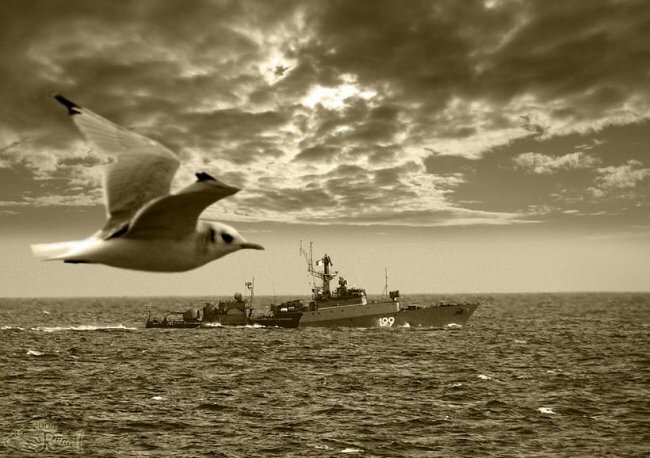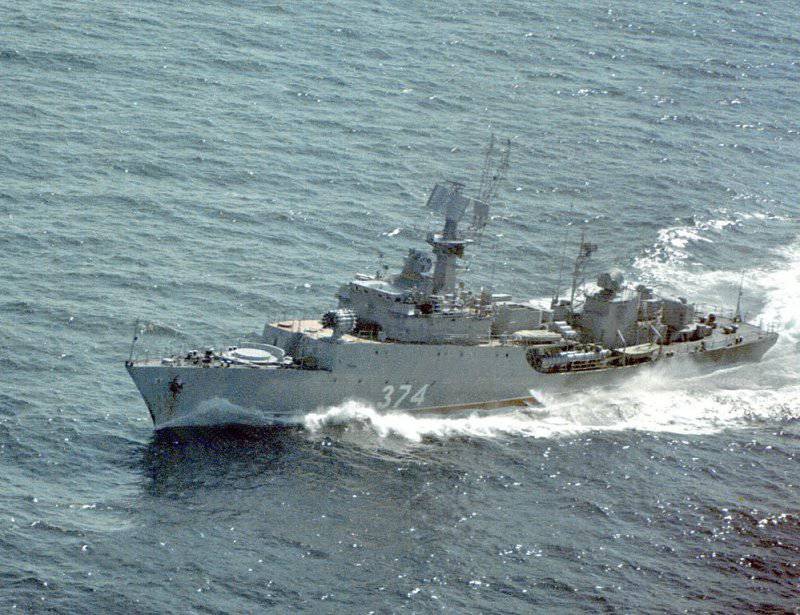Swift "Albatross"
History create
The idea of creating the ship pr.1124 as a specialized high-speed anti-submarine ship of small displacement arose in the 50-60s. XX century, which was due to the emergence abroad of a new generation of submarines and the need to take effective measures to counter them in all marine zones, including and in coastal areas, near naval bases and basing points of domestic ships fleet. The task for the development of a small anti-submarine ship (MPK) pr.1124 "Albatros" was issued in 1963 to Zelenodolsky TsKB-340, which had previously developed patrol ships (ASR) of the first and second generations of anti-submarine defense (PLO). The preliminary design of the new ship (chief designer Yu.A. Nikolsky, observing from the Navy an employee of the Central Research Institute of VC Captain 2nd Rank IV Kozlovsky) was considered in June 1964.
In the technical design of 1965, all the requirements of the Navy were implemented and a sufficiently high-speed specialized ship for search and destruction of submarines near the coast was created with a full displacement of 900 tons. According to the corrected 1972 pr. Approved in 1124, the total displacement of the IPC was 940 t., "ridges" were removed in the surface part of the board, the geometry of the protruding parts of the hull was simplified. The full speed of the ship during the operation of diesel engines and gas turbines exceeded 35 nodes.

Serial construction of the Albatross type IGC was initiated by a decree of the Central Committee of the CPSU and the USSR Council of Ministers No. 680-280 from 10.08.1964, while corrected after tests in the 1970 of the lead ship (MPC-147) was approved in 1972. The lead ship, pr.1124, was laid in 1967 (Gorky CVD, Zelenodolsk), launched in October 1968, and in October 1970 was handed over to the fleet. In the period up to 1986, 1124 ships were built on 38 Ave. (19 on CVD in Zelenodolsk, 14 - on CVD in Khabarovsk, 5 - on CVZ Leninskaya Kuznitsa in Kiev). 1981 to 1983 At the Vladivostok plant, 5 ships were built, 1124 Ave., for sea border units. From 1980, in Zelenodolsk, Khabarovsk and Kiev, construction of modernized ships began on prospect 1124.
appointment
The small anti-submarine ship, the ship Albatros 1124, is designed to search, detect and destroy enemy submarines when carrying out the tasks of guarding naval bases and fleet bases, raids, and also for anti-submarine escort of ships and transports at sea crossings.
Features
The architecture of the IPC pr.1124 was given much attention at the design stage. As a result, the most optimal combined hulls of the ship hull were selected, providing the required speed in 35 nodes. In order to reduce the degree of pouring and splashing, the upper part of the ship had an unconventional saddle deck and a nose superstructure extended over the entire width of the hull.
The main power plant (GEM, developed under the direction of A. Kunakhovich and A. Myshakin) is a three-shaft diesel-gas turbine unit consisting of 2 diesel engines of economic progress (M-507А by 10000 hp each) and a gas turbine engine (GTE, M -8М, 18000 hp), working on the 2 onboard and average shaft respectively. Two diesel engines or gas turbine engines provided the ship with a speed of 20-22 knots, all three - more than 35 knots. Remote engine control. The installation of such a combined power plant was caused by the need to maintain a relatively low course for a long time when searching for submarines on the move, deep acoustic reconnaissance in place and the quickest possible exit to the area of its intended location in order to attack with onboard weapons. In motion under diesel engines, the cruising range at a speed of 18 knots made up at least 2500 miles. The electric power system of the ship is based on 3 diesel generators 200, 300 and 500 kW (total power 1000 kW).
weaponry
The anti-submarine armament of the IPC Ave 1124 includes two twin-tube 533 rotary torpedo tubes DTA-5Е-1124 with self-guided Yenot-2-type torpedoes (SET-65, travel speeds up to 40 units, range up to 15 km. ), placed at the deck behind the nasal superstructure and two 200 barreled rocket bomber installations RBU-12 (stationed at the nasal part, 6000 ammunition rocket depth bombs RGB-96, firing range to 60 km, depth to 6 m, m, depth to 400 m, 20 minutes, depth to 23,5 m, 20 minutes, distance to XNUMX m, 20 minutes, distance to XNUMX m, 20 minutes, X-depth, XNUMX m, 20 minutes kg). For searching, detecting, classifying submarines and issuing target designation, the IPC is equipped with a sub-axial ("Argun") and lowered ("Shelon") hydroacoustic stations.
Weapon Self-defense includes: Osa-M anti-aircraft missile system for combat against air targets (20 missile ammunition, strike and range altitude to 10 km and 60-5000 m) with the Mr-302 "Rubka" radar, located in the nose; the AK-725-MP-103 universal artillery complex as part of the 57 universal twin-turret AK-725 automatic installation (firing range in 12,9 km, 6,7 km altitude) and the Bars "Firing Radar MP-103 (antenna post located on the aft superstructure, capable of sustainably tracking small sea and air targets at a distance of up to 40 km.).

Modifications
IPC pr.1124 (Grisha-I class) - the basic design of a small anti-submarine ship;
MPK 1124-P (Grisha-II class) - in 1973, it was created by order of the KGB of the USSR for parts of the maritime border guard on the basis of the base IPC as a frontier patrol ship (PSKR), pr.1124-P. Instead of the OSA-M SAM system, the second AK-725 gun mount was installed. The project was built 17 PSCR, most of which had their own personal names. In addition, several ships of the base Ave. 1124 were transferred to the Border Troops;
IPC pr.1124 (Grisha-III class) - during serial construction, starting with 13 on the account of the hull, at the beginning of 70. The IPM Ave 1124 is equipped with the AK-725-MP-123 artillery system, the X-NUMX-mm AK-57 and the 725-mm six-barreled artillery AK-30 (range to 630 km), which is intended to defeat the anti-ship winged battalions, in the near field of defense. Control of both installations was carried out by the radar MP-4 "Vympel";
IPC Ave 1124-K (Grisha-IV class) - an experimental ship (MPK-5), on which the Dagger anti-aircraft missile system and the new experienced anti-submarine missile system RPK-5 "Live" (RBU-10000, was installed in the nose) were tested parts instead of RBU-6000, not adopted for service); IPC pr.1124-M (Grisha-V class) - modernized IPC, developed in 1976, Zelenodolsk PKB. It differs from the base project in the new under the rubber Platin, 76-mm AK-176 artillery (instead of 57-mm), Osa-MA (instead of Osa-M), the presence of an auxiliary propulsion and steering complex under the ship's transom. As a result, the ship's displacement increased by 30 t, and the speed decreased by the 3 node. In total, 20 ships of this project were built, and the latter were equipped with a Fregat-MA radar in connection with the cessation of production of the Rubka radar.
The 1124 project ships carried combat service in the 1970-1980-s as part of the Northern, Baltic, Pacific and Black Sea fleets of the Soviet Navy, carrying out search and pursuit of enemy submarines. The Admiral of the Fleet of the Soviet Union, Sergey Georgievich Gorshkov, called the ships of this project "the working horse of the fleet."
In addition to the detection and prosecution of foreign submarines, "albatross" carried out escorting of individual vessels and caravans in hazardous areas. In 1990 — 1991, during the civil war in Ethiopia, the IPC-118 “Komsomol Moldova” carried out military service in the Red Sea. 19 October 1990 while escorting "Komsomol members of Moldova" convoy of two large landing ships, the tanker "Sheksna" and sea trawler "Paravan" detachment of Soviet ships was fired from Cape Caroli and islands Asarco North two coastal batteries Eritrean separatists, has released the head small antisubmarine 6 ship 122-mm shells and 3 uncontrolled Grad-type projectile. The Komsomol Moldavian reciprocated with fire and crushed both batteries and destroyed the enemy’s ammunition depot, for which the ship’s commander and 10 members of his crew received government awards. Over the entire period of combat service in the Red Sea, Komsomolets Moldavia successfully conducted more than 30 convoys.
Small anti-submarine ships of the 1124 project were also used in combat service in the Mediterranean.
In August, the small anti-submarine ships of the Black Sea Fleet Suzdalets, Aleksandrovets, Muromets, Povorino and Kasimov took part in the Russian-Georgian armed conflict as part of the group of ships of the Black Sea Fleet "to ensure the safety of Russian citizens and assist peacekeeping contingent and humanitarian assistance to the population in the conflict zone ". In particular, 2008 of August, Suzdalets MPC, used weapons against Georgian high-speed targets (according to some data, fired three Georgian patrol boats). It was one of the few instances of real combat use of the Osa air defense system against surface targets [10]. According to the results of participation in the conflict, a number of Suzdalts seamen were awarded government awards, and the captain of the ship captain 26 of rank V. Janunts became the holder of the Order of Courage.
Main developer Zelenodolsk PKB
The main producer of CVD in Zelenodolsk, Khabarovsk, in Kiev
Displacement, t: 900 (full)
Full speed, knots Xnumx
Maximum range, 4200 miles (14 nodes), 2700 (35 nodes)
Autonomy, days Xnumx
Armament:
rocket 2x2 533-mm TA; 2х12 RBU-6000 (96 RSL); SAM "Osa-M" 1x2 PU (20 SAM); 12 57-mm AK-725
artillery and infantry ---
Radiotechnical radar MR-302 "Felling", MP-103 "Bars", GAS "Argun" and "Shelon"
The power plant 2 diesel M-507Ах10000 hp; GTD M-8Мх18000 hp
Main dimensions, m 71,1х10,3х3,4
Electric power sources from diesel generator (200, 300 and 500 kW)
Power, kW 1000 kW total

Information